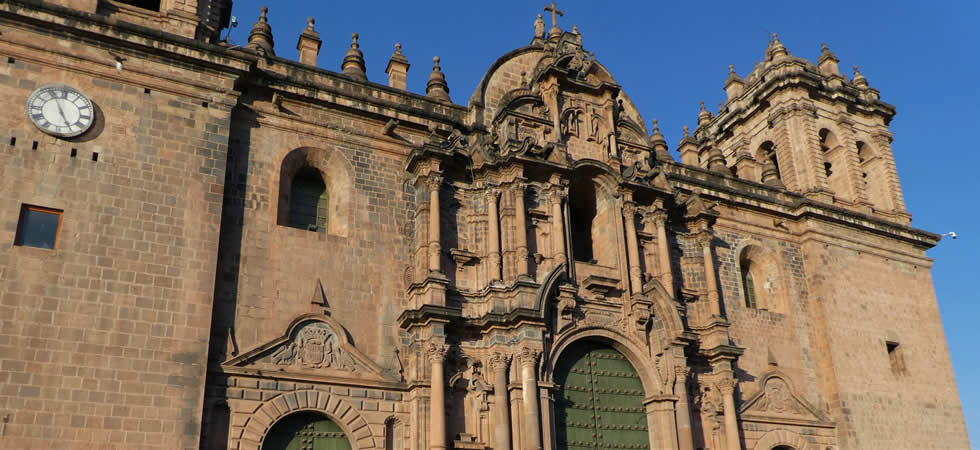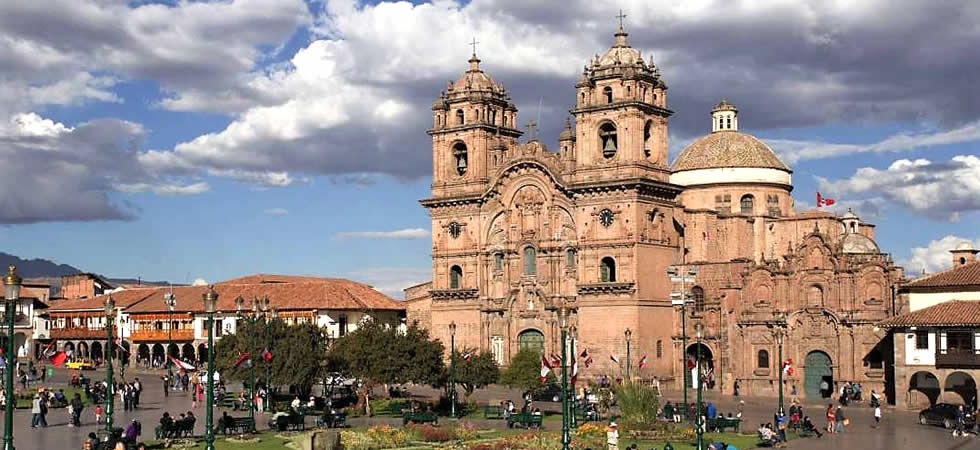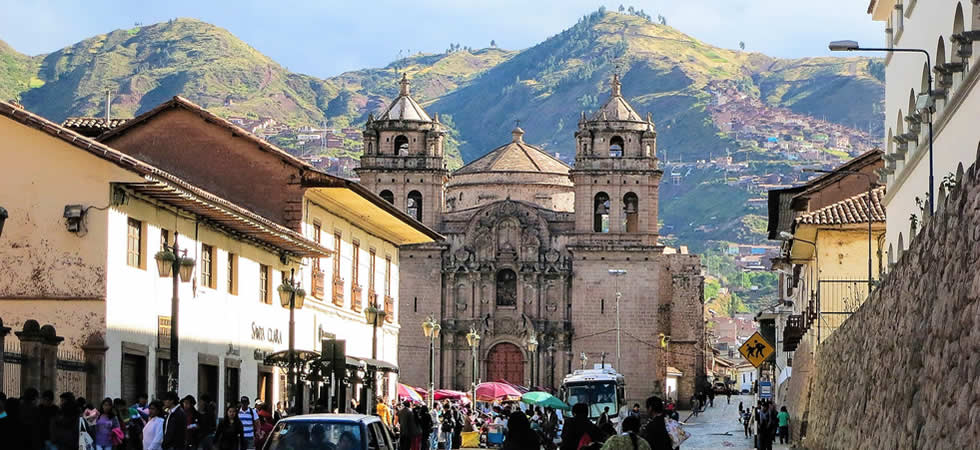Cusco is home to a number of historic churches, many of which date back to the colonial period. Some of the most notable include the Cathedral of Cusco, which was built on the foundations of the Inca palace and is known for its ornate architecture and art. The Church of the Society of Jesus (“La Compañia”), also known as the Jesuits' Church, is another important church in Cusco that features a mix of Renaissance and Baroque architectural styles.
Other notable churches in Cusco include the Church of San Blas, which is known for its intricate stone carvings, and the La Merced, famous for its ornate gold leaf altarpiece. These churches are important not just for their religious significance but also for their cultural and historical value, as they are an integral part of the rich heritage of the city.
Cathedral of Cusco
The Cathedral of Cusco, also known as the Cathedral of the Assumption, is a must-see attraction for any visitor to the city. The Cathedral is located in the main square of Cusco and is known for its ornate architecture and art. The Cathedral was built on the foundations of the Inca palace and is a perfect blend of Inca and Spanish architectural styles.
Inside the Cathedral, you can see several works of art, such as the famous "Last Supper" painting, a colonial-era painting of the Last Supper, and the "Virgin of the Apocalypse" painting, a depiction of the Virgin Mary during the end times. The Cathedral also features several chapels, each with intricate carvings and artwork.
To visit the Cathedral of Cusco, you can purchase a ticket at the entrance, which will give you access to the central nave and the chapels. The Cathedral of Cusco is not only an important religious site but also an important cultural and historical site. You can visit the Cathedral by yourself, or as part of the Cusco City Tour.

Cathedral of Cusco
The Church of San Blas
The Church of San Blas is small but beautiful in the San Blas neighborhood. It is known for its charming streets, Inca stone walls, artisan shops, and traditional houses. In the church, you'll find intricate stone carvings and colonial-era artwork. The church is built on the site of the palace of the Inca emperor, Inca Roca, and is considered one of the oldest churches in Cusco.
Inside the church, you can see several works of art, such as the altarpiece, which is made of cedar wood and gold leaf and is considered one of Cusco's most beautiful. You can also see the image of the patron saint of San Blas, Saint Blas, carved in stone and dates back to the colonial period. The church also features several colonial-era paintings.
To visit the Church of San Blas, you can purchase a ticket at the entrance, which will give you access to the main nave and the chapels. The Church of San Blas is an important religious and cultural site in Cusco. Visiting the Church of San Blas is an excellent way to learn about the past and appreciate the beauty of the present.
Church of La Merced
The Church of La Merced is a beautiful church located in Cusco. It is known for its ornate gold leaf altarpiece and colonial-era artwork. The Mercedarian Order built the church in the 16th century, and is considered one of Cusco's most important religious sites.
Inside the church, you can see several works of art, such as the altarpiece, which is made of wood and covered in gold leaf. It is considered one of the most beautiful in Cusco and is the church's main attraction. You can also see the image of the Virgin Mary, which is carved in stone and dates back to the colonial period.
To visit the Church of La Merced, you can purchase a ticket at the entrance. The church is located in downtown Cusco, close to the main square, and it can be easily reached on foot.

Church of La Merced
Compañia de Jesus
The first foundation of the Compañia church took place on July 17, 1571, by order of the Viceroy Francisco de Toledo, at the initiative of the provincial father Jerónimo Ruiz de Portillo. In 1619, the Jesuit Congregation began the construction of the Colegio de San Bernardo, managing to complete the building, whose main characteristic was a gabled roof with cedar armor, brought from Amaybamba.
In 1651, the Chapel of Our Lady of Loreto (also called the Chapel of the Indians) began, concluding this work in three years. Finally, in 1654, construction work began on the Church of the Company of Jesus, concluding in 17 years, with the participation of many architects and builders.
The Church of the Company of Jesus has a single nave where the imposing main altar, carved in a hybrid style of cedar and utterly gilded with gold leaves, stands out in the background. It measures 21 meters high by 12 meters wide and in the central portion of the altar is the image of the Virgin of the Immaculate Conception above a canvas representing the Transfiguration of Jesus.
The main nave also has a transept that communicates with the two side chapels, six altars with different styles, and a golden pulpit; towards the sides of the main altar, there are another four cedar altars, three of them golden. Finally, it is worth mentioning the canvases that represent the life of the founder of the Order, San Ignacio de Loyola, painted by Marcos Zapata and his assistant Cipriano Gutiérrez.

Compañia de Jesus Church
The Church of San Pedro
The Church of San Pedro is a beautiful church located in Cusco, Peru. It is known for its colonial-era artwork and architecture. The church was built in the 16th century and is considered one of the oldest churches in Cusco.
Inside the church, you see several works of art, such as the altarpiece, which is made of wood and gold leaf. You can also see the image of the patron saint of San Pedro, Saint Peter, which is carved in stone and dates back to the colonial period. The church has a very simple and plain decoration, and it doesn't have many details or ornaments as other churches in Cusco.
The Church of San Pedro is an important religious and cultural site in Cusco, located in the San Pedro neighborhood in the market area nearby the San Pedro Market.

The Church of San Pedro
Santo Domingo Church
The Santo Domingo Church and Convent is situated in Plazoleta Santo Domingo, 5 minutes walking from Plaza de Armas in Cusco; the easiest way to get there from this point is by crossing Loreto Street and then passing through “Pampa del Castillo”.
The Convent of Santo Domingo in Cusco was built on the foundation of the ‘Templo del Sol’ and Qorikancha. The Catholic temple has been erected on the same Inca temple, as though demonstrating the destruction and annulment of the ancient cult; today, it becomes the apse of the Dominican temple. It is an excellent example of the fusion of two cultures, the Incas and the Spanish, and it is a unique representation of Cusco's rich history.
Both the church and the Dominican convent were built over the structure of Qorikancha (golden enclosure), the main Inca temple (dedicated to the cult of the sun), and whose inner walls, according to chroniclers, were covered by sheets of gold.
Monday to Saturday: 8:30a.m.-5:30p.m. Sundays and holidays: 2p.m.-5p.m.
Cost: The price is the same, both for nationals and foreigners Adult: S /. 15.00
San Cristobal church
The San Cristobal Church was built in the early years of the conquest by the Indian chief Cristóbal Paulla, lord of Qolqanpata, as a sign of his devotion to Christianity. The statue of the patron saint is gigantic and is paraded in procession at the Corpus Christi festival.
During the Inca period, this area was in the Hanan Qosqo or high Cusco; the neighborhoods of Pumacurco, Choquechaca, Tacsecocha, and Qolqampata themselves belonged here. This area is the depository of many Inca buildings that are scattered in the area, being part of the Qolqampata palace, which belonged to Manco Cápac, the first Inca.
A large wall platform with eleven niches of cellular structure, as well as remains of Inca architecture of excellent manufacturing, can be seen in the upper part. The Inca Paullo Túpac Yupanqui, converted to the Christian religion, takes commissioner Don Cristóbal Baca de Castro as godfather, whose name he uses to found the hermitage that was built on one side of the small square below the Qolqampata palace.
The church is located on the Plaza San Cristobal, a 10-15-minute walk from the main square, from where you can have great views over the city of Cusco.

San Cristobal church